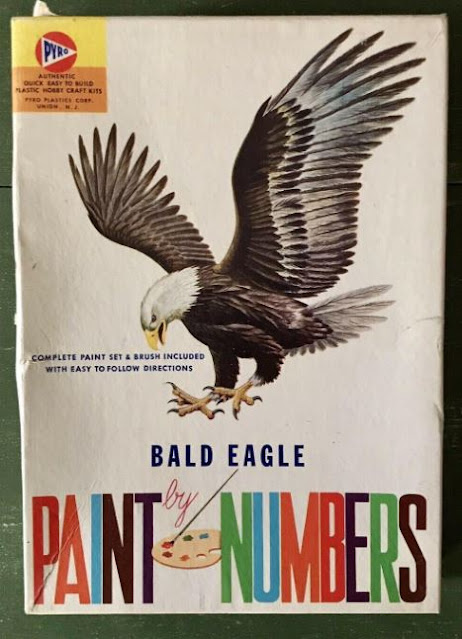The Pyro Plastics Corporation, of Union, New Jersey, was one of the smaller American kit makers.
Originally a general plastics firm, it was active in the kit field from the 1950s until the early 1970s. In 1958 it launched a small series of Bird kits, carrying the Mark Trail name. Mark Trail being a newspaper comic strip, with a conservation theme.
There were only three kits in the series:
C280-.89 American Bald Eagle
C281-.98 Ring-Necked Pheasant
C282-.98 Mallard Duck
The Eagle sold for 89 cents, and the other two for slightly more, at 98 cents. There was apparently also a set, containing all three kits, but I have not seen a picture of this.
All three kits were re-issued in 1963 in new boxes, with new numbers, as Paint-by-Number sets. This being the first such range by Pyro. The paints came on a palette, and were common to all three sets. The colours were generic: black, white, yellow, red, blue, and green. A brush was also included.
All the birds were basically brown, and the kits were moulded in brown plastic (dark brown for the Eagle, and medium brown for the Pheasant and Duck), so only the details and the base needed to be painted.
At some point, possibly 1965 when the Paint-by-Numbers line was extended, the original paints were replaced with NEW ! Water Soluble Paints. This was pointed out on the side of the box, but not on the box tops.
All the kits now sold for 98 cents, although this did increase later. That was good value, given that most of the kits were no more expensive than the original issues, but now included paints and a brush.
The new boxes were basically white, with a full-colour painting of the bird within. This would have undoubtedly helped with finishing the model.
C353-98 Bald Eagle
C354-98 Ring-Necked Pheasant
C355-98 Mallard Duck
In the 1970s the Pyro range, including the birds, went to Life-Like, who sold the kits under the American Wildlife name. According to the Scalemates site, these kits were also issued by Bull Mark, which seems to be a Japanese company. The Eagle has also been re-issued by Lindberg. None of these appear to be Paint-by-Number sets, with paints and a brush, just normal kits.
The series was also released in Britain by Kleeware, as these pages from a 1960 Hobbies Annual list all three kits, with a retail price of 7/- (seven shillings, or 35 New Pence). But the only kit I have seen on-line is the Pheasant. Again, these appear to be the original kits, not the Paint-by-Numbers versions. Kleeware kits of any subject seem to be rare.
Eight photographs, all from Worthpoint
Paul Adams from New Zealand










Boy, I never heard of, or saw, this line of kits anywhere! I think the idea of “paint by numbers” models was another of those concepts designed to lure girls and arty types and families into the plastic model fold, until mfrs understood that plastic models were primarily of interest to young boys, and cars, planes and tanks were the best subjects. I would have found painting a bald edge extremely intimidating, myself! SFZ
ReplyDeleteI know that to a sufficiently skilled modeller, tools are secondary.
ReplyDeleteHowever, I really wonder if anyone was able to create decent results given the brushes and paints that were supplied with 1960s model kits!
I'm imagining scrubbing a paint-loaded brush against a pad of newspaper to get a dry-brush effect, but my imagination is still coming up short!
Did any of these manufacturers in their cost-cutting frenzy, think about the disservice they were doing to their customers by supplying such poor materials?
I think you’ve hit the mail on the head. In order to paint a subject like this correctly, you would need the proper paint, in several colors, and a good assortment of brushes, none of which came with these kits. I do think the result was frustrating to most people, and that may be why this concept never flew. I feel like I saw or tried a paint by numbers kit somewhere along the line, and the paints were terrible water colors, which wouldn’t even stick to the plastic. SFZ
DeleteI think the attraction of these kits, or at least their intended sales appeal, was that everything needed to complete the kit was included in the box (although not the cement in this case). The kits were moulded in brown plastic, the main colour of each bird, so that just left the detail painting.
ReplyDeleteI do not know what the paints were like, but the brushes do not look great. In my limited experience with normal paint-by-number sets in the 1970s, the brushes were indeed a major problem. Fine, detail work was just about impossible.
The inclusion of only basic colours in most of these sets also left you to do a lot of paint mixing. In contrast, Bachmann tailored the colours in each set to the actual subject.
A fabulous tour round these kits Paul, all quite wonderful and evocative of a simpler time. Well done on cataloguing kits like this for MC. We're much obliged.
ReplyDeleteI kinda wish they still made these kits.
ReplyDeleteMy wife would love things like this if she had the time.
(Instead, she collects old taxidermy mounts.)
Our house is small, and I have to share it with a full body mount of a spotted Hyena....